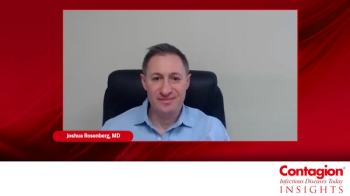According to the World Health Organization, October 24 marks World Polio Day which was designed, “to raise awareness of the importance of polio vaccination to protect every child from this devastating disease, and to celebrate the many parents, professionals and volunteers whose contributions make polio eradication achievable. To ensure a polio-free future for everyone, efforts must continue to maintain high immunization coverage, implement high-quality surveillance to detect any presence of the virus, and prepare to respond in the event of an outbreak.”1
“Polio Day gives us the opportunity to recognize the extraordinary progress we have made in eradicating only the second human disease in history, the first, the first disease that was eradicated was smallpox, and polio is onboard to be the only, only, the second human disease to be eradicated,” said Carol Pandak, EdD, director of PolioPlus, Rotary International. “So it's an opportunity to recognize the progress, but also to talk about what challenges remain and why it's important to finish the job.”
Of the 3 types of the polio strain, wild poliovirus type 1, wild poliovirus type 2, and wild poliovirus type 3, both type 2 and 3 have been eradicated. Pandak points out only 2 countries (Afghanistan and Pakistan) have never stopped the transmission of the wild polio virus, down from over 100 countries. 2
For people afflicted with polio, in the acute stage of the disease, patients can suffer paralysis. And in addition to the initial infection, people can suffer from a condition called Post-Polio Syndrome (PPS) that can affect survivors years later. According to the Centers for Disease Control and Prevention, PPS affects between 25 and 40 out of every 100 polio survivors. And it can begin approximately 15 to 40 years after the initial infection. Individuals can experience muscle weakness, fatigue, and joint pain. 3
Polio Statistics
According to Rotary International here are some statistics about polio vaccination and surveillance.
- The average cost to protect a child from polio is $3
- 430 million children in total were vaccinated in 39 countries in 2017
- It costs $100 million to conduct polio surveillance worldwide. 3
Rotary International
One of the foremost leaders in the fight against the disease, Rotary International, was responsible for initiating the global fight to end polio. Rotary members have donated $2.8 billion and countless volunteer hours to help immunize 3 billion children and eliminate polio in 122 countries. 4
Rotary and its Global Polio Eradication Initiative (GPEI) partners (WHO, CDC, UNICEF, Bill and Melinda Gates Foundation, or Gavi, the Vaccine Alliance) have reduced polio cases by more than 99.9% percent worldwide. The massive polio eradication infrastructure (largest-ever global public health initiative, per WHO) and Rotary’s “PolioPlus” system support broader health systems, inform other infectious disease outbreak strategies, and guard against pandemics.
“There used to be 350,000 cases of polio every year. That's 1000 children a day being affected by polio, paralyzed or even dying. Today, only 2 countries have never stopped the transmission of the wild polio virus. And last year, there were just 12 cases of wild polio,” Pandak said.
The US and Polio
Here in the US, with the population vaccinated, the disease has been mostly dormant for years; however, there is the rare case that does happen. Two years ago, there was a single case of circulating vaccine-derived poliovirus (cVDPV). The case of polio was reported to be in an unvaccinated 20 year old man who contracted the virus. The person is said to have suffered paralysis. The case occurred in Rockland County, NY. Circulating vaccine-derived poliovirus occurs when local immunity to poliovirus is low enough to allow prolonged transmission of the original weakened virus in the oral polio vaccine.5
As the virus circulates and more genetic changes occur, the virus can regain its ability to infect the central nervous system and cause paralysis. It’s important to note that cVDPVs are not caused by a child receiving the polio vaccine.5
The 2022 case was the first in the US since 2013. The last case to originate here was in 1979. Polio can originate from different countries and travelers can bring it back to the US.5
Polio in Low and Middle Income Countries (LMIC)
Pandak points out there were just 12 cases of wild polio last year. Despite these promising numbers, the need to continue vaccination remains, and people in LMIC are at the greatest risk.
“You do have cases where there are shortages of vaccines in some of the lower income countries, but one of the goals of the global health community is to reduce that inequity between the high income countries and low income countries, such that every child has access to the vaccines they need to grow up healthy and strong, “ Pandak said.
References
1.World Polio Day. WHO. Accessed October 24, 2024 https://www.who.int/europe/campaigns/world-polio-day
2.Poliomyelitis (polio). WHO. Accessed October 24, 2024
https://www.who.int/health-topics/poliomyelitis#tab=tab_1
3.About Polio in the United States. Centers for Disease Control and Prevention. Updated May 9, 2024. Accessed October 24, 2024
https://www.cdc.gov/polio/about/index.html
4.Ending Polio. Rotary International. Accessed October 24, 2024.
https://www.rotary.org/en/our-causes/ending-polio
5. Parkinson J. CDC: US is Country With Circulating Vaccine-Derived Polio. Contagion. September 13, 2024. Accessed October 24, 2024. https://www.contagionlive.com/view/cdc-us-is-country-with-circulating-vaccine-derived-polio
































































































































































































































































































































